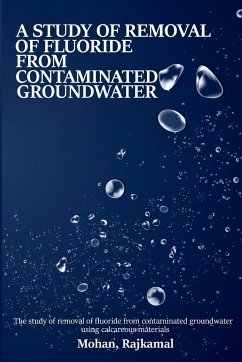General Introduction This thesis presents a comprehensive study of the removal of fluoride from water using different calcium containing materials. The study comprises of defluoridation of contaminated water using some calcium containing materials viz., Lime-sludge waste (LSW) in presence of PA, Hydroxyapatite-coated-limestone in continuous fixed-bed column, limestones of different geographical origin and a field trial conducted in some of the fluoride affected villages of Assam, India using the Phosphoric Acid-crushed limestone treatment (PACLT) method at community and household level. Safe water supply is the backbone of a healthy economy, yet it is woefully under prioritized, globally. Securing access to safe drinking water would help immensely in reducing illness and death, especially among children. With the rise in global industrialization, growing population, increasing domestic and agricultural activities and other environmental changes around the world, the problem of drinking water crisis has emerged in many parts of the world, both in urban as well as rural areas. In 2019, some 2.2 billion people around the world still don't have access to safe drinking water [1]. The statistics revealed significant differences, with the poorest and those who live in remote areas having the lowest likelihood of having access to a basic water service. Despite the fact that groundwater constitutes merely 0.6% of the entire water resources on earth, it is the primary and most favoured supply of drinking water in rural and urban areas, mainly in the developing countries such as India and China [2]. Due to lack of access to safe drinking water and proper sanitation, millions of people die every year from mostly preventable diseases. A wide variety of organic, inorganic and bacteriological pollutants enters the aquifers via different natural as well as anthropogenic sources, contributing to the water crisis. One such inorganic contaminant, Fluoride has been contaminating groundwater as well as surface water due to different natural and anthropogenic activities. Some natural phenomena which causes fluoride contamination in groundwater are weathering of fluoride bearing rocks and minerals, volcanic eruption and volcanic ash [3]. On the other hand, anthropogenic activities like wet and dry depositions of gaseous (e.g., HF, SiF4), particulate fluorides (e.g., AlF3, NaAlF6, CaF2) emissions from glass and ceramic factories, petroleum refineries, aluminium and steel industries, phosphate fertilizer plants, coal-burning power plants, semiconductor and electroplating plants, brick and iron works, soil dust and crustal.
Hinweis: Dieser Artikel kann nur an eine deutsche Lieferadresse ausgeliefert werden.
Hinweis: Dieser Artikel kann nur an eine deutsche Lieferadresse ausgeliefert werden.








